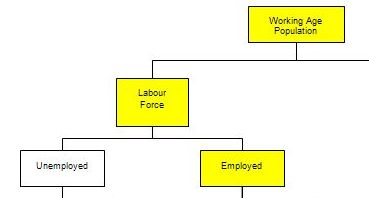
As long as employment growth keeps pace with labour force growth, unemployment will not rise.
Answer: False
The answer is False.
If you didn't get this correct then it is likely you lack an understanding of the labour force framework which is used by all national statistical offices.
The labour force framework is the foundation for cross-country comparisons of labour market data. The framework is made operational through the International Labour Organization (ILO) and its International Conference of Labour Statisticians (ICLS). These conferences and expert meetings develop the guidelines or norms for implementing the labour force framework and generating the national labour force data.
The rules contained within the labour force framework generally have the following features:
The system of priority rules are applied such that labour force activities take precedence over non-labour force activities and working or having a job (employment) takes precedence over looking for work (unemployment). Also, as with most statistical measurements of activity, employment in the informal sectors, or black-market economy, is outside the scope of activity measures.
Paid activities take precedence over unpaid activities such that for example 'persons who were keeping house' as used in Australia, on an unpaid basis are classified as not in the labour force while those who receive pay for this activity are in the labour force as employed.
Similarly persons who undertake unpaid voluntary work are not in the labour force, even though their activities may be similar to those undertaken by the employed. The category of 'permanently unable to work' as used in Australia also means a classification as not in the labour force even though there is evidence to suggest that increasing 'disability' rates in some countries merely reflect an attempt to disguise the unemployment problem.
The following diagram shows a partial view of the Labour Force framework used by the statisticians in this context.
The Working Age Population (WAP) is usually defined as those persons aged between 15 and 65 years of age or increasing those persons above 15 years of age (recognising that official retirement ages are now being abandoned in many countries).
As you can see from the diagram the WAP is then split into two categories: (a) the Labour Force (LF) and; (b) Not in the Labour Force - and this division is based on activity tests (being in paid employed or actively seeking and being willing to work).
The Labour Force Participation Rate is the percentage of the WAP that are active.
You can also see that the Labour Force is divided into employment and unemployment. Most nations use the standard demarcation rule that if you have worked for one or more hours a week during the survey week you are classified as being employed.
If you are not working but indicate you are actively seeking work and are willing to currently work then you are considered to be unemployed.
If you are not working and indicate either you are not actively seeking work or are not willing to work currently then you are considered to be
Not in the Labour Force.
So you get the category of hidden unemployed who are willing to work but have given up looking because there are no jobs available. The statistician counts them as being outside the labour force even though they would accept a job immediately if offered.
Now trace through the yellow boxes which are linked by the following formulas:
Labour Force = Employment + Unemployment = Labour Force Participation Rate times the Working Age Population
Consider the following Table which shows the Labour Force aggregates for a stylised nation and the WAP, Labour Force and Employment are all growing at a constant rate (in this case 2 per cent).
You observe unemployment rising although the unemployment rate is constant as is the participation rate.
The reason is that the Labour Force is a larger aggregate than Employment because it would be impossible for unemployment to be zero (frictions alone - people moving between jobs - will deliver some small positive unemployment).
So although both the Labour Force and Employment grow at a constant rate, the gap between them (Unemployment) gets larger each period although the proportion of the Labour Force that is unemployed remains constant.
You may wish to read the following blog for more information: